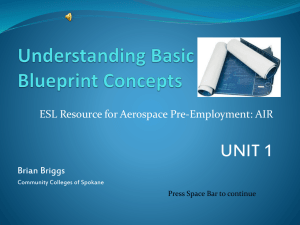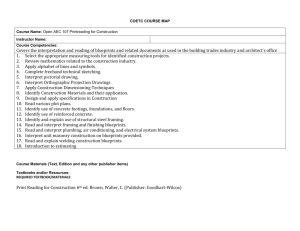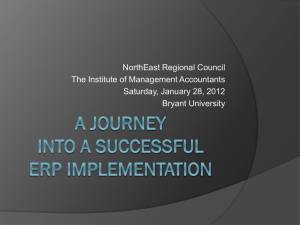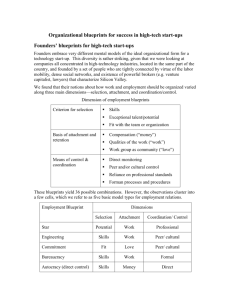PART 1: INTRODUCTION
advertisement
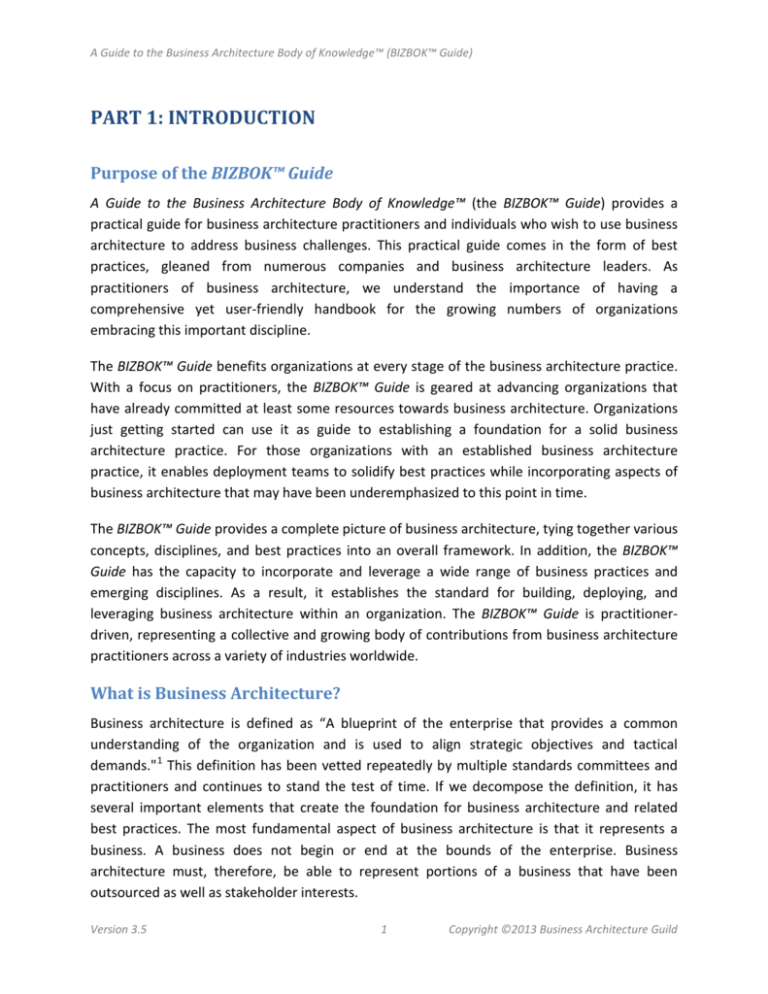
A Guide to the Business Architecture Body of Knowledge™ (BIZBOK™ Guide) PART 1: INTRODUCTION Purpose of the BIZBOK™ Guide A Guide to the Business Architecture Body of Knowledge™ (the BIZBOK™ Guide) provides a practical guide for business architecture practitioners and individuals who wish to use business architecture to address business challenges. This practical guide comes in the form of best practices, gleaned from numerous companies and business architecture leaders. As practitioners of business architecture, we understand the importance of having a comprehensive yet user-friendly handbook for the growing numbers of organizations embracing this important discipline. The BIZBOK™ Guide benefits organizations at every stage of the business architecture practice. With a focus on practitioners, the BIZBOK™ Guide is geared at advancing organizations that have already committed at least some resources towards business architecture. Organizations just getting started can use it as guide to establishing a foundation for a solid business architecture practice. For those organizations with an established business architecture practice, it enables deployment teams to solidify best practices while incorporating aspects of business architecture that may have been underemphasized to this point in time. The BIZBOK™ Guide provides a complete picture of business architecture, tying together various concepts, disciplines, and best practices into an overall framework. In addition, the BIZBOK™ Guide has the capacity to incorporate and leverage a wide range of business practices and emerging disciplines. As a result, it establishes the standard for building, deploying, and leveraging business architecture within an organization. The BIZBOK™ Guide is practitionerdriven, representing a collective and growing body of contributions from business architecture practitioners across a variety of industries worldwide. What is Business Architecture? Business architecture is defined as “A blueprint of the enterprise that provides a common understanding of the organization and is used to align strategic objectives and tactical demands." 1 This definition has been vetted repeatedly by multiple standards committees and practitioners and continues to stand the test of time. If we decompose the definition, it has several important elements that create the foundation for business architecture and related best practices. The most fundamental aspect of business architecture is that it represents a business. A business does not begin or end at the bounds of the enterprise. Business architecture must, therefore, be able to represent portions of a business that have been outsourced as well as stakeholder interests. Version 3.5 1 Copyright ©2013 Business Architecture Guild A Guide to the Business Architecture Body of Knowledge™ (BIZBOK™ Guide) In addition, various aspects of a real world business must be represented in some abstract format. In business architecture, we call these abstractions. Figure 1.1 depicts the high-level domains within a business represented within the business architecture. Who? & Where? What? Customers, Partners & Competitors Why? Policies, Rules, Regulations Who? & Where? Capabilities Organization What? How? How Well? Vision, Strategies & Tactics What? Information Value Streams Products & Services Initiatives & Projects Decisions & Events Metrics & Measures Business Architecture Why? How? When? Figure 1.1: Aspects of the Business Represented by Business Architecture Domains represented in figure 1.1 are related to each other in various ways. A business is broken down into business units, which have certain capabilities. Capabilities are enabled through a series of value streams, which require information. Organization, capability, value, and information comprise the foundation of the business architecture. This core is represented by the inner circle in figure 1.1. These four categories are considered foundational because they are relatively stable compared to other aspects of the business. For example, a one hundred year old insurance company would have had similar capabilities as it does today: Customer Management, Policy Management, and Claims Management. While these capabilities would not have had automation one hundred years ago, they still existed, along with certain business units and value streams such as Process Claim. The company would have also used similar information such as Customer, Policy, or Claim. The extended view of the business architecture, shown in the outer rim of the circle in figure 1.1, depicts aspects of the business that change more frequently but serve to extend the Version 3.5 2 Copyright ©2013 Business Architecture Guild A Guide to the Business Architecture Body of Knowledge™ (BIZBOK™ Guide) business architecture in a variety of ways. Customers and competitors may have existed one hundred years ago, but it is quite likely that they were very different from today’s customers and competitors. Similarly, the products being delivered may change quite frequently along with decisions, strategies, tactics, policies, and regulations. These variations are why the outer rim of figure 1.1 is separated from the core. Blueprint sections 2.2 through 2.5 reflect the focus on building out the core, while the remaining sections within part 2 represent extensions to the business architecture. Business architecture represents real world aspects of a business, along with how they interact, to help executives answer commonly asked questions: who, what, where, when, why, and how. Answers to these questions, derived from the business architecture, are used to develop plans, and make and implement business decisions. This is the essence of business architecture and a foundation for the material presented within the BIZBOK™ Guide. Of course, representing this information is one thing, making it useful to individuals who need only a portion of this information at a given time and have little time or patience to sort through the details introduces another aspect of business architecture: blueprints. Blueprints are abstract representations of reality. The concept of blueprints represents a wide variety of business viewpoints. There are building blueprints, ship blueprints, and, in our discussion, business blueprints. A given blueprint is one view of the business. There are many types of business blueprints, as shown in the examples in figure 1.2, that allow us to visualize the business from a variety of perspectives. The blueprints shown in figure 1.2 represent a sampling of commonly used business viewpoints. Each blueprint provides management with information about a given aspect of the business within a specific context. For example, the Balanced Scorecard, shown in figure 1.2, provides management with measures against certain business goals and objectives. One important difference between business architecture produced versions of balanced scorecards, dashboards, and related blueprints from traditional financial reporting is that business architecture focuses on the essence, structure, and overall transparency of the business, not on financial performance. Just as a blueprint of a ship would not provide statistics on top speed attained on an Atlantic crossing or average speed per crossing, the business architecture does not provide financial analytics. Financial reporting systems will continue to produce financial performance results for business teams. The business architecture would, however, identify how effective the organization is in building financial analytics and where it can improve this capability from a holistic perspective. Version 3.5 3 Copyright ©2013 Business Architecture Guild A Guide to the Business Architecture Body of Knowledge™ (BIZBOK™ Guide) Figure 1.2: Business Architecture Represented by Business Blueprints Business architecture opens up an entirely new level of business transparency that allows management teams to streamline planning, evaluate the value of funded initiatives against strategies, and craft more effective transformation roadmaps. This is possible because business architecture blueprints stem from a common vocabulary, standardized framework, and shared business knowledgebase. This means that dashboard results align in practice with value streams, capabilities, information views, goals, and other business viewpoints. As a result, executives, managers, planning teams, analysts, and other stakeholders see the business through a common set of lenses – eliminating much of the confusion often found across business units, strategy sessions, and projects. The BIZBOK™ Guide walks practitioners through the creation and use of these business blueprints including organizational blueprints, capability maps, value streams, information assets, and other viewpoints that play a role in the practice of business architecture. The BIZBOK™ Guide also provides insights into how to use these blueprints individually and collectively to achieve business goals through an overall framework. Version 3.5 4 Copyright ©2013 Business Architecture Guild A Guide to the Business Architecture Body of Knowledge™ (BIZBOK™ Guide) Business Architecture Framework Basic business architecture concepts and the ability to visualize this information in a variety of ways is only part of the business architecture story. Organizing this information in useful ways and being able to relate and combine these concepts requires a foundational framework, shown in figure 1.3. The framework concept does not impose prescriptive or restrictive concepts into the practice of business architecture. Rather, the framework provides a foundation that organizations can build upon and customize based on unique business architecture requirements, driven by real world challenges. Business Architecture Scenarios Business Architecture Blueprints Figure 1.3: The Business Architecture Framework There are three important components within the business architecture framework: business blueprints, business architecture scenarios, and the business architecture knowledgebase. As we discussed, business blueprints deliver business transparency that enables and streamlines business transformation across business units, capabilities, and stakeholders. The degree of transparency delivered by these blueprints rarely exists in many organizations today. As a result, many planning sessions miss essential understanding of how to maximize solutionrelated investments while ensuring that one business unit’s success does not create problems for the enterprise as a whole. For example, consider the company that was creating multiple, competing enrollment solutions for the same customer base across multiple product lines. Each project could have succeeded in principle, yet created more complexity and dissatisfaction across the customer base. Business architecture provides the transparency to discover these Version 3.5 5 Copyright ©2013 Business Architecture Guild A Guide to the Business Architecture Body of Knowledge™ (BIZBOK™ Guide) issues in advance, before money and good will are squandered. Essential business architecture blueprint building and usage are discussed in detail in part 2 of the BIZBOK™ Guide. The framework also incorporates the concept of business architecture scenarios, which provide business transparency on specific business initiatives. Business architecture is applied differently based on the type of scenario at hand. For example, a business team involved in a merger and acquisition would require different information than another team considering how to stem customer attrition. Applying business architecture through various business scenarios, thereby leveraging blueprint views derived from the business architecture knowledgebase, enables business teams to create and deploy a wide variety of transformation roadmaps. Because this approach is based on a common view of the business across business units, it enables improved executive sponsorship and more sustainable funding structures. Scenario topics covered in the BIZBOK™ Guide include: • • • • • • • • • • • • Investment Analysis Shift to Customer Centric Business Model Merger & Acquisition Analysis New Product/Service Rollout Globalization Business Capability Outsourcing Supply Chain Streamlining Divestiture Regulatory Compliance Change Management Operational Cost Reduction Joint Venture Deployment These business architecture scenarios define the collective set of initiatives, programs, and projects that leverage business architecture. One important aspect of every scenario is that of a suggested roadmap for that particular scenario. Business architecture scenario approaches are discussed in detail in part 4 of the BIZBOK™ Guide. The business architecture knowledgebase is used to store the information about the business, organized in concise ways that are customized to a given organization’s environment. For example, corporations have divisions and departments while governments may use different terminology. How the knowledgebase is organized dictates, in part, how businesses can be viewed. There are generic approaches to knowledgebase structure as well as organizationspecific approaches. For example, a government agency would have unique organizational structures in comparison to a hospital or shipping company. Knowledgebase management is Version 3.5 6 Copyright ©2013 Business Architecture Guild A Guide to the Business Architecture Body of Knowledge™ (BIZBOK™ Guide) discussed in part 5 of the BIZBOK™ Guide and is also incorporated into various blueprint discussions. Business Architecture Principles Business architecture is principle-driven. A principle is an agreed upon truth that can guide one’s reasoning. The principle-driven approach offers practitioners a wide degree of latitude in the practice of establishing and leveraging business architecture. Each major section has a set of principles that guide actions associated with individual blueprints and related practice areas. Core principles that apply to business architecture as a whole are listed below: 1. 2. 3. 4. 5. 6. Business architecture is about the business. Business architecture’s scope is the scope of the business. Business architecture is not prescriptive. Business architecture is iterative. Business architecture is reusable. Business architecture is not about the deliverables. We emphasize that a principle-based approach to business architecture leaves practitioners with the option to employ a variety of methods, visualization techniques, tools, and governance concepts. The common thread is that each approach adheres to a foundational set of principles that aligns the practice of business architecture without dictating how the work is done or restricting the creativity of the practitioner. While using various portions of the BIZBOK™ Guide, look for the principles section that serves as a foundation for best practices in that particular topic area. Business Architecture Value Stream We use a common business architecture blueprint, the value stream, to define the major stages involved in delivering value to the collective set of business stakeholders benefitting from business architecture. In keeping with an important business architecture mapping concept, we have additionally identified the essential capabilities that enable each stage of the value stream. While capabilities define what a business does, the value stream is an end-to-end collection of activities that deliver value to internal and external stakeholders. In figure 1.4, we outline six stages of the business architecture value stream. It is important to note that the value stream is reentered every time a stakeholder triggers the need for a business architecture assisted solution. To provide additional insights into this value stream, we have mapped a series of capabilities to each stage that identify what may be done at each stage to achieve stakeholder value. All value stream stages and capabilities are defined in appendix B.1. Version 3.5 7 Copyright ©2013 Business Architecture Guild A Guide to the Business Architecture Body of Knowledge™ (BIZBOK™ Guide) Figure 1.4: The Business Architecture Value Stream The first stage of the value stream in figure 1.4 stresses the importance of establishing business motivations for use of business architecture. The second stage performs a needs analysis and determines the role business architecture will play going forward, including scenario focus. Using business architecture, the third stage establishes a clear view of the business as it relates to the current state of the business from viewpoints relevant to the scenario at hand. Stage four uses business architecture and related business disciplines to architect business solutions based on business priorities. The fifth stage defines initiatives required to achieve the goals set in stage one and implement the solutions crafted in stage four. The last stage delivers the ultimate degree of stakeholder value – a deployed solution and confirmation of success. Note that while there is a capability for addressing business-driven IT architecture definition under stage four, this value stream is not meant to encompass all aspects of a software development solution. Inclusion of this capability is merely meant to demonstrate that business Version 3.5 8 Copyright ©2013 Business Architecture Guild A Guide to the Business Architecture Body of Knowledge™ (BIZBOK™ Guide) solutions requiring IT architecture planning and definition would do so within this stage. Business/IT alignment concepts are incorporated within part 6 of the BIZBOK™ Guide. The value stream in figure 1.4 is not a one-time event but one that will happen many times over based on business issues that arise. In other words, this is a recurring value stream that organizations will be able to apply for years into the future as new and unique challenges arise. The value stream leverages the three key aspects of the business architecture framework: blueprints, scenarios, and the knowledgebase. This value stream concept is employed across various business architecture scenarios detailed in part 4. The BIZBOK™ Guide Content Summary The BIZBOK™ Guide is organized into nine major parts. A part may be divided into several sections. An overview of the BIZBOK™ Guide is shown below. • Part 1: Introduction – Part 1 overviews the BIZBOK™ Guide as incorporated herein. • Part 2: Business Architecture Blueprints – Part 2 includes detailed mapping discussion of common business blueprints along with guidelines for how to use these blueprints in practice. o Section 2.1: Business Strategy Mapping – Discusses how business strategy and objectives play a role within business architecture. o Section 2.2: Capability Mapping – Details the definition, benefits, development, and use of business capabilities in planning and other business areas. The section includes building the capability map and mapping capabilities to other aspects of the business. o Section 2.3: Organization Mapping – Discusses mapping organizational structures into the business architecture and covers business unit mapping and inclusion of various stakeholders into the business architecture. o Section 2.4: Value Mapping – Outlines the definition, benefits, development, and use of value maps within the context of business architecture. Also included are detailed approaches on value stream mapping and the use of value maps within the context of business planning and transformation. o Section 2.5: Information Mapping – Information is the backbone of the business, and this section provides a business view of information and its role in business architecture. o Section 2.6: Initiative Mapping – Discusses approaches for visualizing business initiatives within the context of business architecture. Version 3.5 9 Copyright ©2013 Business Architecture Guild A Guide to the Business Architecture Body of Knowledge™ (BIZBOK™ Guide) o Section 2.7: Product Mapping – Maps a business’s products (and services), and cross-maps them to other aspects of business architecture. o Section 2.8: Stakeholder Mapping – The stakeholder concept is an important part of business architecture, which this section maps to value streams. • Part 3: Business Architecture Practice – Part 3 provides perspectives on a wide variety of business architecture practices, like getting started, governance, business model mapping, mapping to related business disciplines, and tooling options. o Section 3.1: Common Approaches for Getting Started – Discusses how to get started with business architecture and outlines a typical timeline from business planning through deployment. o Section 3.2: Business Architecture Governance – Incorporates best practices for governing business architecture within an enterprise. Topics include team alignment, role definition, and collaborative governance across a business. o Section 3.3: Business Architecture and Business Model Frameworks – A business model describes the rationale of how an organization creates, delivers, and captures value, and this section discusses how to use business architecture to turn business models into actionable results. o Section 3.4: Business Architecture and Business Process Modeling and Management – Discusses the relationship between business architecture and business process management. o Section 3.5: Business Architecture and Case Management – Case management is an important business design concept, and this section discusses how business architecture provides a framework for delivering case management solutions in practice. o Section 3.6: Business Architecture and Lean Six Sigma – Lean Six Sigma is a widely used discipline for improving business performance, and this section provides guidelines for aligning Lean Six Sigma to business architecture. o Section 3.7: Business Architecture and Business Performance Management – Business performance management enables a business to measure and report on behaviors, results, and successes. This section introduces the role of business architecture in measuring and improving business performance. o Section 3.8: Business Architecture Tooling Options – Discusses business architecture tool categories that may be leveraged to enable and improve business architecture blueprint creation and related practices. Version 3.5 10 Copyright ©2013 Business Architecture Guild A Guide to the Business Architecture Body of Knowledge™ (BIZBOK™ Guide) o Section 3.9: Business Architecture Maturity Model – Provides an overview of a framework for evaluating the overall maturity of a business architecture practice and deployment. It also provides a summary perspective of business architecture maturity and introduces Appendix B.3, which contains the complete Business Architecture Maturity Model. • Part 4: Business Architecture Scenarios – Part 4 focuses on best practices for addressing common business scenarios, including the list identified in this section and additional scenarios to be added over time. • Part 5: The Business Architecture Knowledgebase – Part 5 discusses how to organize and manage business architecture concepts and artifacts using a formal mapping approach. • Part 6: Business Architecture and IT Architecture Alignment – Part 6 discusses various approaches for aligning business architecture and IT architecture in order to deliver IT solutions that more closely align to the needs of the business. o Section 6.1: Business Architecture and IT Architecture Alignment Overview – Introduces the overall approach and context for business architecture / IT architecture alignment, including a summary of mapping approaches. o Section 6.2: Business Architecture and Enterprise Architecture Framework Alignment – Provides guidelines for using business architecture within the context of enterprise architecture, with a specific focus on the Zachman framework and the TOGAF framework. o Section 6.3: Business Architecture and Requirements Alignment – Business architecture can inform and improve business requirements analysis, and this section introduces this concept and related approach. o Section 6.4: Capability and Application Portfolio Management – Provides a business value oriented approach to application portfolio management. o Section 6.5: Business Architecture and SOA Alignment – Discusses the use of business capabilities in informing and articulating service-oriented architecture from a business perspective. o Section 6.6: Business Information and IT Architecture Alignment – Outlines how business information, as defined in section 2.5, impacts the evolution of IT data and application architectures. o Section 6.7: Business Architecture and IT Architecture Transformation – Business/IT architecture transformation is the culmination of business Version 3.5 11 Copyright ©2013 Business Architecture Guild A Guide to the Business Architecture Body of Knowledge™ (BIZBOK™ Guide) architecture / IT architecture alignment, and this section discusses how organizations can achieve business-driven, business/IT architecture transformation. • Part 7: Business Architecture Case Studies – As the Business Architecture Guild collects real world examples and lessons learned from using business architecture to solve business issues, we will showcase them in this section. • Part 8: Industry Reference Models – Part 8 offers selected industry reference models that may be used as a source of information for building business architecture. • Appendix A: Glossary • Appendix B.1: Business Architecture Value Stream and Capability Definitions • Appendix B.2: Business Architecture Roles and Competencies • Appendix B.3: Business Architecture Maturity Model • Appendix C: Study Questions • Appendix D: Version History • Appendix E: Editorial Board and Contributors The Business Architecture Guild A Guide to the Business Architecture Body of Knowledge™ (BIZBOK™ Guide) will evolve to incorporate an evolving set of best practices emerging in the field. This will be accomplished through membership participation in the Business Architecture Guild, a not-for-profit organization of business architecture practitioners. The Guild is dedicated to advancing the profession of business architecture; the BIZBOK™ Guide represents the consensus, formalization, and documentation of best practices and knowledge from active members of the Guild. We appreciate comments, corrections, and new contributions. For more information, go to www.businessarchitectureguild.org 1 OMG Business Architecture Special Interest Group, http://bawg.omg.org, and Business Architecture Institute, www.businessarchitectureinstitute.org Version 3.5 12 Copyright ©2013 Business Architecture Guild
